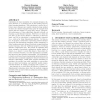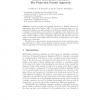588 search results - page 57 / 118 » Computing the Dimension of Linear Subspaces |
KDD
2006
ACM
14 years 10 months ago
2006
ACM
Calculation of object similarity, for example through a distance function, is a common part of data mining and machine learning algorithms. This calculation is crucial for efficie...
CDC
2009
IEEE
14 years 1 months ago
2009
IEEE
We describe semidefinite programming methods for system realization and identification. For each of these two applications, a variant of a simple subspace algorithm is presented, i...
ECCV
2004
Springer
14 years 12 months ago
2004
Springer
Abstract. Dimensionality reduction is an essential aspect of visual processing. Traditionally, linear dimensionality reduction techniques such as principle components analysis have...
GFKL
2005
Springer
14 years 3 months ago
2005
Springer
Projection pursuit was originally introduced to identify structures in multivariate data clouds (Huber, 1985). The idea of projecting data to a lowdimensional subspace can also be ...
ICDE
2003
IEEE
14 years 11 months ago
2003
IEEE
Iceberg-cube mining is to compute the GROUP BY partitions, for all GROUP BY dimension lists, that satisfy a given aggregate constraint. Previous works have pushed anti-monotone co...


